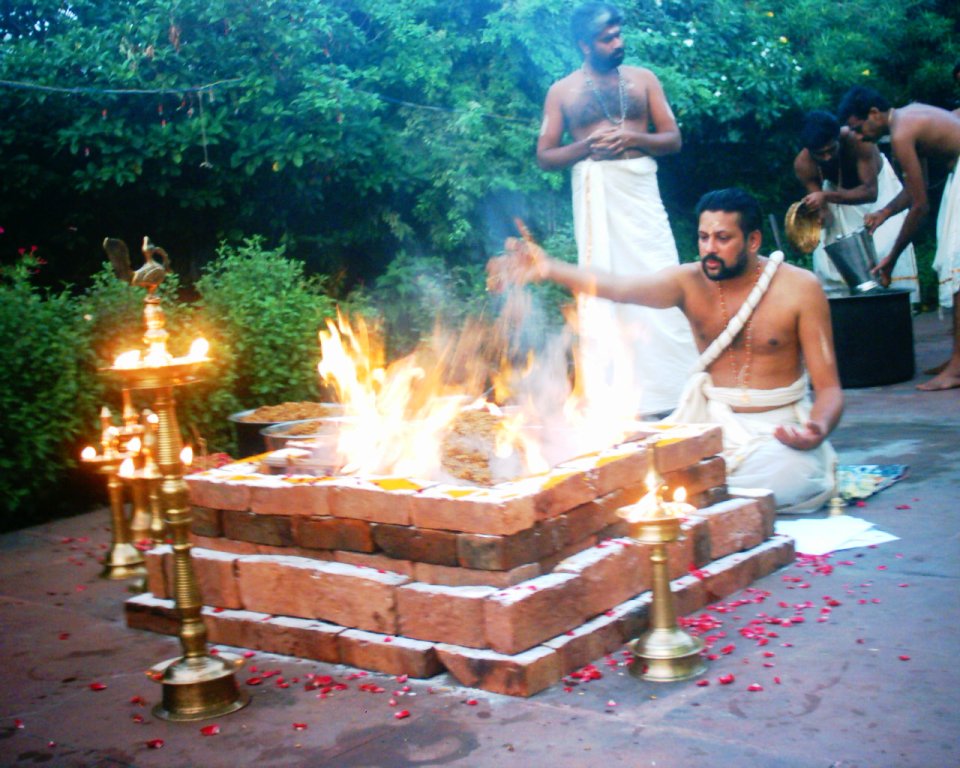|
Pakayajna
The Pakayajna () or Pakayaga (ISO: ) is a Hindu ritual. It is a type of Yajna associated with the Vedic sacrifices of cooked food offering, and regarded as an obligatory ritual ( nitya-karma) for a householder. The term "''paka''" means "cooked" or "prepared". Unlike other types of sacrifices, such as Haviryaga, which involves the offering of uncooked food, a Pakayajna utilizes cooked food material such as bhat. The food (rice of other grains) is cooked in a pot made out of clay called "sthālī", and then offered in the yajna fire during the ritual. Types The seven types of Pakayajna are:Gautama Dharma Sutras 8-19, page no.74, Chaukhamba Samskrit Samthan, Varanasi * ''Aṣṭakā'' * ''Pārvaṇa'' * ''Śrāddha'' * ''Śrāvaṇī'' * ''Āgrahāyaṇī'' * ''Caitrī'' * ''Āśviyujī'' See also * Vedas * Yajna In Hinduism, ''Yajna'' or ''Yagna'' (, Help:IPA/Sanskrit, ɐd͡ʒɲə ) also known as Hawan, is a ritual done in front of a sacred fire, often with mantra ... [...More Info...] [...Related Items...] OR: [Wikipedia] [Google] [Baidu] |
Yajna
In Hinduism, ''Yajna'' or ''Yagna'' (, Help:IPA/Sanskrit, [jɐd͡ʒɲə], ) also known as Hawan, is a ritual done in front of a sacred fire, often with mantras. Yajna has been a Vedas, Vedic tradition, described in a layer of Vedic literature called Brahmanas, as well as Yajurveda. The tradition has evolved from offering oblations and libations into sacred fire to symbolic offerings in the presence of sacred fire (Agni). Yajna rituals-related texts have been called the ''Karma-kanda'' (ritual works) portion of the Vedic literature, in contrast to the ''Jnana-kanda'' (knowledge) portion found in the Vedic Upanishads. The proper completion of Yajna-like rituals was the focus of Mimansa school of Hindu philosophy. Yajna have continued to play a central role in a Hindu's rites of passage, such as weddings. Modern major Hindu temple ceremonies, Hindu community celebrations, or monastic initiations may also include Vedic Yajna rites, or alternatively be based on Āgama (Hinduism), A ... [...More Info...] [...Related Items...] OR: [Wikipedia] [Google] [Baidu] |
ISO 15919
ISO 15919 is an international standard for the romanization of Indic scripts. Published in 2001, it is part of a series of romanization standards by the International Organization for Standardization. Overview Relation to other systems ISO 15919 is an international standard for the romanization of many Brahmic scripts, which was agreed upon in 2001 by a network of the national standards institutes of 157 countries. However, the Hunterian transliteration system is the "national system of romanization in India" and a United Nations expert group noted about ISO 15919 that "there is no evidence of the use of the system either in India or in international cartographic products." Another standard, United Nations Romanization Systems for Geographical Names (UNRSGN), was developed by the United Nations Group of Experts on Geographical Names (UNGEGN) and covers many Brahmic scripts. The ALA-LC romanization was approved by the Library of Congress and the American Library Ass ... [...More Info...] [...Related Items...] OR: [Wikipedia] [Google] [Baidu] |
Hindus
Hindus (; ; also known as Sanātanīs) are people who religiously adhere to Hinduism, also known by its endonym Sanātana Dharma. Jeffery D. Long (2007), A Vision for Hinduism, IB Tauris, , pp. 35–37 Historically, the term has also been used as a geographical, cultural, and later religious identifier for people living in the Indian subcontinent. It is assumed that the term ''"Hindu"'' traces back to Avestan scripture Vendidad which refers to land of seven rivers as Hapta Hendu which itself is a cognate to Sanskrit term ''Sapta Sindhuḥ''. (The term ''Sapta Sindhuḥ'' is mentioned in Rig Veda and refers to a North western Indian region of seven rivers and to India as a whole.) The Greek cognates of the same terms are "''Indus''" (for the river) and "''India''" (for the land of the river). Likewise the Hebrew cognate ''hōd-dū'' refers to India mentioned in Hebrew BibleEsther 1:1. The term "''Hindu''" also implied a geographic, ethnic or cultural identifier for ... [...More Info...] [...Related Items...] OR: [Wikipedia] [Google] [Baidu] |
Nityakarma
Nityakarma () refers to obligatory Vedic duties that are prescribed for daily practice in Hinduism. Nityakarma is among the three ritual actions classified by the Mimamsa philosophy, along with nisiddhakarma and kamyakarma. It is also featured in the Shaiva Siddhanta philosophy. Description According to Parasara, the six activities are regarded to be nityakarmas: *Snana (bathing) *Sandhyavandanam (morning and evening prayers) *Recitation of the Vedas *Veneration of ancestors * Homam (offerings to fire) *Tarpana ''Tarpana'' or (, , , ) is a term in the Hinduism, Vedic practice that refers to an offering made to divine entities. It refers to the act of offering as well as the substance used in the offering. ''Tilatarpana'' (, , , ) is a specific form of ... (worship of the gods) See also * Kamyakarma * Shrauta References Rituals in Hindu worship Hindu philosophical concepts {{Hindu-philo-stub ... [...More Info...] [...Related Items...] OR: [Wikipedia] [Google] [Baidu] |
Haviryaga
The Haviryaga (ISO: ) or Haviryagna () is a Hindu ritual. It is a type of Yajna associated with the Vedic sacrifices of uncooked offering, and regarded to achieve various spiritual and material benefits. The term "''Haviryaga''" means "a sacrifice in which ''havis'', i.e. uncooked food is used" . Unlike other types of sacrifices, such as Somayajna, which involve the offering of soma juice, a Haviryaga utilizes food materials such as rice, barley, ghee, and milk. The main purpose of such sacrifices is to invoke blessings and ensure material prosperity and happiness in life. Types The seven types of Haviryaga are: * ''Agnyadhana'' * ''Agnihotra-Homa'' * ''Darsa-purnamasa Istis'' * ''Agrayanesti'' * ''Caturmasya'' * ''Nirudha Pasubandha'' * ''Sautramani'' Agnyadhana A Vedic sacrifice requires three sacred fires namely ''Ahavaniya'', ''Garhapatya'' and ''Daksinagni''. The purpose of ''Adhana'' is to entertain these three sacred fires. It has regular precribed procedure for ... [...More Info...] [...Related Items...] OR: [Wikipedia] [Google] [Baidu] |
Cooked Rice
Cooked rice refers to rice that has been cooked either by steaming or boiling. The terms steamed rice or boiled rice are also commonly used. Any variant of Oryza sativa, Asian rice (both Indica rice, indica and Japonica rice, japonica varieties), Oryza glaberrima, African rice or wild rice, glutinous rice, glutinous or non-glutinous, long-, medium-, or short-grain, of any colour, can be used. Rice for cooking can be brown rice, whole-grain or white rice, milled. Cooked rice is used as a base for various list of fried rice dishes, fried rice dishes (e.g. chǎofàn, khao phat), rice bowls/plates (e.g. bibimbap, chazuke, rice and curry, curry rice, dal bhat, donburi, loco moco, panta bhat, rice and beans, rice and gravy), rice porridges (e.g. congee, juk (food), juk), rice balls/rolls (e.g. gimbap, onigiri, sushi, zongzi), as well as rice cakes and desserts (e.g. mochi, tteok, yaksik). Rice is a staple food in not only Asia and Latin America, but across the globe, and is the most c ... [...More Info...] [...Related Items...] OR: [Wikipedia] [Google] [Baidu] |
Dharma
Dharma (; , ) is a key concept in various Indian religions. The term ''dharma'' does not have a single, clear Untranslatability, translation and conveys a multifaceted idea. Etymologically, it comes from the Sanskrit ''dhr-'', meaning ''to hold'' or ''to support'', thus referring to law that sustains things—from one's life to society, and to the Universe at large. In its most commonly used sense, dharma refers to an individual's moral responsibilities or duties; the dharma of a farmer differs from the dharma of a soldier, thus making the concept of dharma a varying dynamic. As with the other components of the Puruṣārtha, the concept of ''dharma'' is pan-Indian. The antonym of dharma is ''adharma''. In Hinduism, ''dharma'' denotes behaviour that is considered to be in accord with ''Ṛta''—the "order and custom" that makes life and universe possible. This includes duties, rights, laws, conduct, virtues and "right way of living" according to the stage of life or social posi ... [...More Info...] [...Related Items...] OR: [Wikipedia] [Google] [Baidu] |
Varanasi
Varanasi (, also Benares, Banaras ) or Kashi, is a city on the Ganges river in northern India that has a central place in the traditions of pilgrimage, death, and mourning in the Hindu world.* * * * The city has a syncretic tradition of Islamic artisanship that underpins its religious tourism.* * * * * Located in the middle-Ganges valley in the southeastern part of the state of Uttar Pradesh, Varanasi lies on the left bank of the river. It is to the southeast of India's capital New Delhi and to the southeast of the state capital, Lucknow. It lies downstream of Prayagraj, where the confluence with the Yamuna river is another major Hindu pilgrimage site. Varanasi is one of the world's oldest continually inhabited cities. Kashi, its ancient name, was associated with a kingdom of the same name of 2,500 years ago. The Lion capital of Ashoka at nearby Sarnath has been interpreted to be a commemoration of the Buddha's first sermon there in the fifth century BCE. In the ... [...More Info...] [...Related Items...] OR: [Wikipedia] [Google] [Baidu] |
Vedas
FIle:Atharva-Veda samhita page 471 illustration.png, upright=1.2, The Vedas are ancient Sanskrit texts of Hinduism. Above: A page from the ''Atharvaveda''. The Vedas ( or ; ), sometimes collectively called the Veda, are a large body of religious texts originating in ancient India. Composed in Vedic Sanskrit, the texts constitute the oldest layer of Sanskrit literature and the oldest Hindu texts, scriptures of Hinduism. There are four Vedas: the Rigveda, the Yajurveda, the Samaveda and the Atharvaveda. Each Veda has four subdivisions – the Samhitas (mantras and benedictions), the Brahmanas (commentaries on and explanation of rituals, ceremonies and sacrifices – Yajñas), the Aranyakas (text on rituals, ceremonies, sacrifices and symbolic-sacrifices), and the Upanishads (texts discussing meditation, philosophy and spiritual knowledge).Gavin Flood (1996), ''An Introduction to Hinduism'', Cambridge University Press, , pp. 35–39A Bhattacharya (2006), ''Hindu Dharma: Introduc ... [...More Info...] [...Related Items...] OR: [Wikipedia] [Google] [Baidu] |
Hindu Rituals
Samskara (Sanskrit: संस्कार, IAST: , sometimes spelled ''samskara'') are sacraments in Hinduism and other Indian religions, described in ancient Sanskrit texts, as well as a concept in the karma theory of Indian philosophies. The word literally means "putting together, making perfect, getting ready, to prepare", or "a sacred or sanctifying ceremony" in ancient Sanskrit and Pali texts of India. In the context of karma theory, samskaras are dispositions, characters or behavioural traits that exist as default from birth or prepared and perfected by a person over one's lifetime, that exist as imprints on the subconscious according to various schools of Hindu philosophy such as the yoga (philosophy), Yoga school. These perfected or default imprints of karma within a person, influences that person's nature, response and states of mind.Stephen H. Phillips (2009), Yoga, Karma, and Rebirth: A Brief History and Philosophy, Columbia University Press, , Chapter 3 In another ... [...More Info...] [...Related Items...] OR: [Wikipedia] [Google] [Baidu] |





